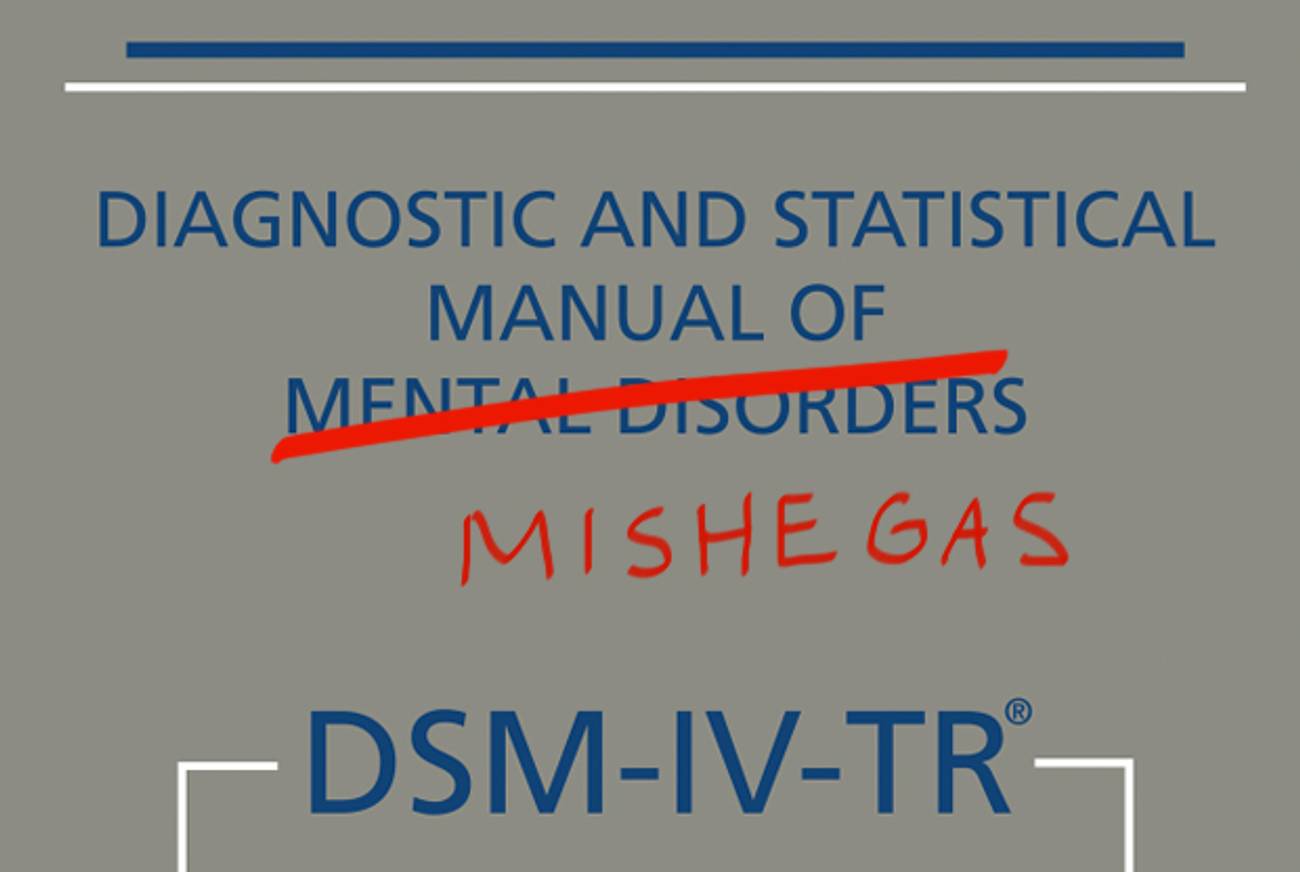Diagnostic Manual of Mishegas
A different version of the famed manual of mental disorders




Potchkied together and .com-piled by Jay Neugeboren, Michael B. Friedman, and Lloyd I. Sederer, M.D.
Based on a newly discovered document by the brilliant if frequently farmisht Dr. Sol Farblondget, M.D., Ph.D., P.T.A.
The Diagnostic Manual of Mishegas (DMOM) is a delightful parody of the American Psychiatric Association’s “Bible of psychiatry,” the DSM (Diagnostic and Statistical Manual of Mental Disorders). In a playful send-up of the DSM, the authors—all of whom are distinguished writers with deep roots in the field of mental health—cut through the hundreds of categories in the 1,000-page DSM by dividing all mental disorders into two realms: mishegas major and mishegas minor. The full manual can be purchased here.
TABLE OF CONTENTS
1. Origins of the DMOM
2. Introduction: How Diagnostic Criteria Are Organized
3. Categories of Mishegas
1.0 Nervous Conditions of Everyday Life
1.01 Tsuris Reactions and Sequelae
1.02 Tsuris-addiction
1.02A The Wisdom of Gornish Helfin
1.03 Verklempt
1.04 Finster in di oygen
1.05 Tsimmis
1.06 Plotz
1.07 Farmisht
1.08 Fartoots
1.09 Fartsadikt
1.10 Fertummelt
1.11 Ferdrayt
1.12 Farfolen
1.13 Fershlugginah
1.14 Spilkes Minor and Spilkes Major
1.14.1 Spilkes Minor
1.14.2 Spilkes Major
2.0 Cockamamy Conditions of Character
2.01 Schmuck
2.02 Schlemiel
2.03 Schlemazel
2.04 Shmegegge
2.05 Shmendrick
2.06 Shnook, Shmo, Shlub, Yutz, Putz
2.07 Shnorrer
2.08 Kvetch
2.09 Noodj
2.10 Yenta
2.11 Momzer
2.12 Chalaria
2.13 Alrightnik (masculine), Alrightnikeh (feminine)
3.0 Categories of Mishegas Relating to Food, Sex, and Age
3.01 Alter Kocker (AK)
3.02 Dementia With Benefits
3.03 Fresser
3.04 Chazzer
3.05 Mishugener Eating Categories Not Elsewhere Classified
3.06 Shikker
3.07 Farshlepteh Krenk
4.0 Appendix Relating to Ethics and Matters Otherwise Unspecified
THE DIAGNOSTIC MANUAL OF MISHEGAS
Introduction: How Diagnostic Criteria Are Organized
Organized?! Who are we kidding? This book—boruch hashem and hallelujah!—is splendidly dis-organized. If you want organized, you’re reading the wrong book. But if you want wisdom, laughs, and astonishing insights into just how mishugah life can be—if you want to learn how to cope with mishegas and glory in it, then read on! Because what we have here are diagnostic categories—cannily ongepotchket (slapped together creatively, as in a Rube Goldberg contraption), and arranged according to Doctor Sol Farblondget’s cunning reductio ad absurdum (and when we say absurdum, we ain’t just talking) that reduces the mishegas of this world into two major categories: Mishegas Major … and Mishegas Minor.
Mishegas Major: As Sol explained to the shmendricks who were working on the DSM, mishegas major refers to someone who is really, really mishugah—for example, a man who, persuaded by his doctor that he is not a chicken, continues to lay eggs.
Mishegas Minor: This category refers to most of us most of the time. We’re all a little mishugah, right? For example, a young woman who worries because the young man she is engaged to is more excited by a New York Knicks victory than oral sex.
Some ethnic and religious groups, such as Jews, Puerto Ricans, Italians, and SCLIFs (Senior Citzens Living in Florida) love dwelling on their mishegas (as in familiar conversational tropes such as “You think your mother-in-law is mishugah? Ha! Wait till you meet mine!”). Others, such as WASPs—the mishegoyim—insist on giving highest priority and value not only to non-expression of feelings and to an insistence on buying retail, but to tight lips and tighter asses (for an analysis of this phenomenon, see Sol Farblondget’s seminal paper “The Riddle of the Sphincter: WASPS, Sexual Inhibition, and Bowel Retention”).
Cultural variations complicate diagnosis, and differences between mishegas major and mishegas minor may not always be clear. A for-instance: Is a man alone in a car and hearing voices having an attack of mishegas major or mishegas minor if he keeps shouting to the empty seat next to him: “I told you a thousand times, Esther—I know which way to turn to get onto the Merritt Parkway, so stop hocking (nagging) me already!” And does the diagnosis depend upon the hearing of voices, familiar or imagined (as in: “Now listen to me, God, you sadistic momzer—if you tell me one more time that ‘Yes, my child, bad things happen to good people, and this too shall pass,’ I’ll drive this car right through your pearly gates with Esther lashed to the hood!”), or on whether or not the voices enable him to make the correct turns?
About the authors:
JAY NEUGEBOREN is the author of 20 books, including two novels, two books of non-fiction, and four collections of stories. He has been keynote speaker for many mental health organizations, including the U. S. Department of Health and Human Services, and has served as a consultant to the World Health Organization. His most recent book is The American Sun & Wind Moving Picture Company.
LLOYD I. SEDERER, M.D., is Medical Director of the New York State Office of Mental Health, and Medical Editor for Mental Health for The Huffington Post. He has served as Mental Health Commissioner of the New York City Department of Health and Mental Hygiene, and as Medical Director of McLean Hospital in Belmont, Massachusetts. His most recent book is The Family Guide to Mental Health Care.
MICHAEL B. FRIEDMAN, M.S.W., a former Regional Director of the New York State Office of Mental Health, is a founder of The Center for Policy and Advocacy of the Mental Health Association of New York City. He teaches health and mental health policy at Columbia University’s Schools of Social Work and of Public Health, and publishes regularly in The Huffington Post and Mental Health News and other periodicals.